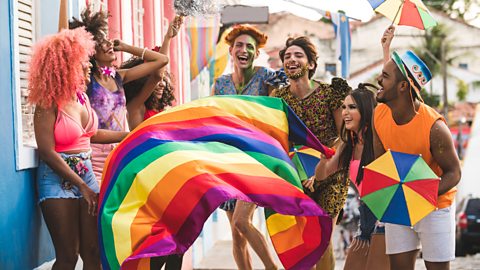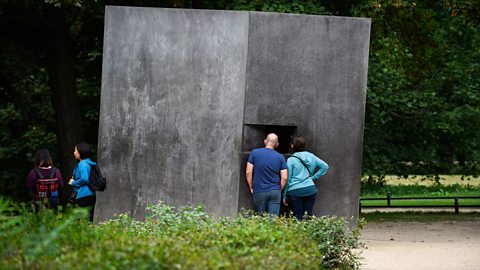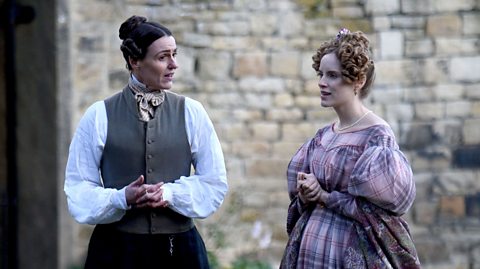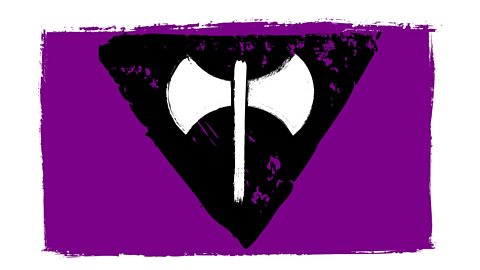ItÔÇÖs Pride Month, and 2022 marks the 50th anniversary of the UKÔÇÖs very first Pride march in 1972.
So far this year has seen everything from the unveiling of the Royal MintÔÇÖs new rainbow-coloured Pride 50p, to the announcement that a trans actress has joined the cast of Doctor Who. ┬ÚÂ╣ď╝┼─ Bitesize takes a look at how LGBTQ+ history has been commemorated.

Plaques
You may have noticed the blue plaques installed on certain buildings across England. These renowned historical markers are currently awarded by English Heritage, and are the oldest scheme of its kind in the world.
Many LGBTQ+ figures have been recognised with a blue plaque, whether it be for helping challenge public perceptions of sexuality and gender, or for significant contributions to their fields. Recipients of the blue plaque include the writers Radclyffe Hall, EM Forster, Virginia Woolf and Oscar Wilde, as well as the artist and activist Derek Jarman and the mathematician and computing pioneer Alan Turing.
English Heritage only install up to 12 new plaques each year. As a result, a number of plaque projects have been created to celebrate people that the wider public may not have otherwise known. These initiatives pay tribute to notable luminaries, such as The Black Plaque Project's recognition of the first openly gay professional British footballer, Justin Fashanu, and The Rainbow Plaques Project's marker for the lesbian diarist Anne Lister.
Pride marches
On 28 June 1970, a group of LGBTQ+ activists organised a march to demand civil rights in the streets of New York City. This protest is now recognised as one of the first ever Pride marches. The parade was sparked by the Stonewall uprising a year earlier, when a group of LGBTQ+ people rioted following police raids of a gay bar called Stonewall Inn. This kickstarted what is commonly acknowledged as the beginning of the modern LGBTQ+ rights movement.
Pride marches soon began to take place worldwide, often against a backdrop of homophobia. The oldest, and now largest, Pride march in Southeast Asia is the Metro Manila Pride in the Philippines, which started as an organised commemoration of StonewallÔÇÖs 25th anniversary in 1994, and has carried on since its formal establishment in 1996.
Shortly after there was a 1999 march in Kolkata, India, which began with barely 15 participants in total, and all of which were men. In 2015, Kingston, Jamaica held Pride JA, the first Pride celebration in the English-speaking Caribbean, a symbolic event for LGBTQ+ campaigners in the island nation.

Memorials
Many LGBTQ+ people have been commemorated for their achievements, and public memorials play a significant role in bringing communities together. In 2008, Berlin commissioned a monument to remember the thousands of LGBTQ+ people imprisoned in concentration camps in Nazi Germany. The memorial, a concrete cube structure, has a small window, where visitors can watch a short film depicting a same-sex kiss.
A decade later the Brazilian artist, Est├║dio Guto Requena created a sculpture called, ÔÇśMy heart beats like yoursÔÇÖ, set in S├úo PauloÔÇÖs iconic Pra├ža da Rep├║blica. It celebrates the first meeting of the LGBTQ+ activist community which took place in 1978.
Just off of ManchesterÔÇÖs Canal Street is Sackville Gardens, home to a number of memorials, including a life-size Alan Turing statue and the Transgender Remembrance Memorial. It also has the Beacon of Hope sculpture, the UKÔÇÖs only permanent memorial for all people living with or who have lost their lives to AIDS or HIV.
LGBTQ+ History Month
The UKÔÇÖs LGBTQ+ History Month takes place every February and aims to promote equality and diversity. This includes educating people on laws, such as Section 28, which have played a key role in shaping identities.
Section 28 was a controversial piece of legislation introduced by Margaret ThatcherÔÇÖs Conservative government in 1988. Its purpose was to prevent local authorities from ÔÇśpromoting homosexualityÔÇÖ. Under this law, schools were unable to teach anything about LGBTQ+ life during lessons. It was repealed in Scotland in 2000 and in England and Wales in 2003, with LGBTQ+ History Month beginning shortly after in 2005.

Flags
Over the course of history, symbols have become increasingly important to the identity of LGBTQ+ groups, with everything from the pink triangle to the A labrys is a double-headed axe which has featured in Greek and Roman mythology. It was adopted as a symbol of strength by the lesbian community in the 1970s. used to communicate reclamation or representation. Perhaps one of the most universally recognisable of all these being the rainbow flag.
The openly gay artist and drag queen, Gilbert Baker, designed the first rainbow flag, which was flown for the first time on 25 June 1978 during the San Francisco Gay Freedom Day parade. Baker would later reveal that he created the symbol of pride for the community with the help of the first openly gay elected official in the US, Harvey Milk.
To celebrate the rainbow flags 25th anniversary, Baker broke his own world record by making a gigantic flag for Key West Pride in 2003. The banner was 1.25 miles long and stretched sea to sea from the Gulf of Mexico to the Atlantic Ocean. The flag was later cut into sections that were distributed to more than 100 cities around the world!
This article was published in June 2022
LGBTQ+ coded languages
Explore the world of Polari and the diaries of Anne Lister (Gentleman Jack).

Pride Month: Six symbols of pride
We look at some modern and historic symbols of alliance, protest and pride.

Four LGBTQ+ superheroes you need to know about
We take a look at some of the superheroes who are part of the LGBTQ+ community.
